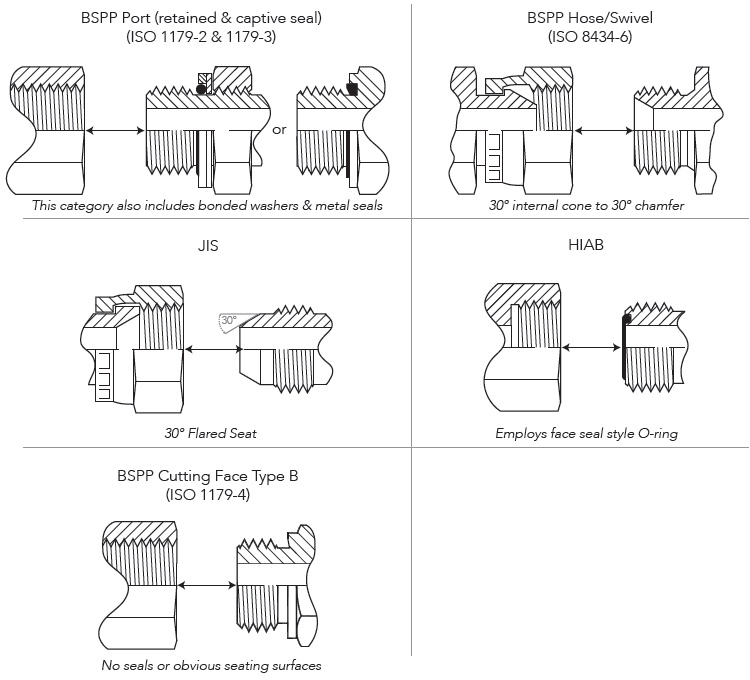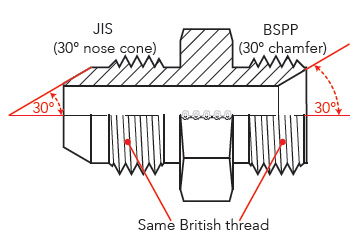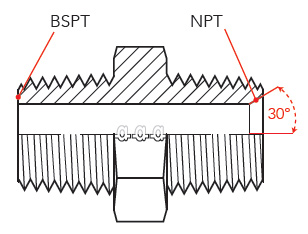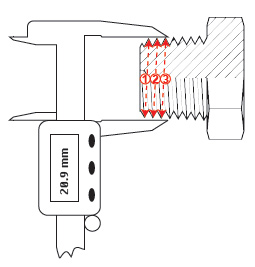How to Identification of BSPP,BSPT, NPT threads?
When you choose valves and pipe fittings, thread is a very important feature you have to consider. No matter how well the product is made, a wrong thread type will make it useless. You have to determine the thread type before you order.
British Standard Pipe fittings are among the most popular of all foreign threads in the world today. These threads come in two versions: parallel (BSPP), and tapered (BSPT). The thread flank angle for both tapered and parallel British threads is 55°. Although BSP is a foreign thread, it isn’t actually metric. This is why it comes in Imperial sizes: 1/8, 1/4, 1/2, 3/4, etc.
BSP parallel (BSPP) threads commonly seal via a 30° chamfer on the male thread to a 30° cone seat inside the female thread (swivel only). If it is a port application, an O-ring and washer, Elastomeric seal or a bonded washer are needed to achieve a proper seal for parallel threads. For tapered BSP threads (BSPT), a seal is accomplished via thread wedging with additional support from thread dope or tape. As previously mentioned, it is possible for a male BSPT (tapered) to thread into a female BSPP (parallel), so long as the female thread is fixed and not swivel (this is because the recessed cone seat could interfere with clearance). To identify a BSPP fitting complete the following steps:
- Confirm the thread is parallel or tapered.
- Determine the threads per inch (TPI) count using a thread gauge or calipers.
- Determine the thread O.D (male thread) or I.D (female thread) using calipers.
- Find a match on the adjacent chart by combining your O.D or I.D measurement with the TPI you measured.
- If a seal or angled sealing surface exists, use it to identify which specific type of British fitting it is on the chart to the right.
- To simplify this process, try Adaptall’s TGK (thread gauge kit).
Use the diagram to your right to confirm what type of British fitting you have. Use caution as “multi-purpose fittings” exist that accommodate 2 or more sealing styles in one fitting (such as Adaptall’s 9005ES series that can be used for BSPP port or swivel connection).
BSPP Thread Specification Chart
| Tapered Male X Tapered Female | Parallel Male X Parallel Female | Tapered Male X Parallel Female | Tapered Male X Tapered Female | Parallel Male X Parallel Female | Tapered Male X Parallel Female | Tapered Male X Parallel Female |
|---|---|---|---|---|---|---|
| 02 | 1/8 | 28 | 9.6 | 0.38 | 8.6 | 0.34 |
| 04 | 1/4 | 19 | 13 | 0.51 | 11.9 | 0.47 |
| 06 | 3/8 | 19 | 16.5 | 0.65 | 15.2 | 0.6 |
| 08 | 1/2 | 14 | 20.8 | 0.82 | 19.1 | 0.75 |
| 10 | 5/8 | 14 | 22.8 | 0.9 | 20.8 | 0.82 |
| 12 | 3/4 | 14 | 26.3 | 1.04 | 24.6 | 0.97 |
| 16 | 1 | 11 | 33.1 | 1.3 | 30.7 | 1.21 |
| 20 | 1-1/4 | 11 | 41.8 | 1.64 | 39.4 | 1.55 |
| 24 | 1-1/2 | 11 | 47.7 | 1.88 | 45.5 | 1.79 |
| 32 | 2 | 11 | 59.5 | 2.34 | 57.4 | 2.26 |
| 40 | 2-1/2 | 11 | 75.1 | 2.95 | 72.6 | 2.86 |
| 48 | 3 | 11 | 87.9 | 3.46 | 85.4 | 3.36 |
BSPP Threads and Sealing Methods


Japanese (JIS) tapered and parallel fittings
Japanese (JIS) tapered and parallel fittings are identical to British standard pipe threads, and are therefore considered to be in the ‘British Fitting’ group. The only difference is that parallel JIS threads have a 30° cone seat on the male end, and a 30° flared seat on the female ends. JIS tapered threads are identical to BSPT threads. Please refer to the BSPP and BSPT thread charts above for details.

British tapered threads (BSPT)
For British tapered threads (BSPT) caution should be taken as the most common tapered fitting in North America is NPT. The easiest way to distinguish any tapered fitting type from NPT is to verify if a chamfered sealing surface exists. If it does the fitting is most likely NPT. If not, it is either BSPT or Metric Taper (Metric Taper is far less common).
To verify the thread is BSPT, you would undergo the same steps as for a parallel British thread. First, verify the number of threads per inch. Second, measure the O.D. at the 3-4th thread from the end of the fitting. You can cross-reference your measurements to the following chart in order to verify the fitting is BSPT.
BSPT Thread Specification Chart
| Dash Size | Nom. Thread Size | Threads per inch (TPI) | Male Thread O.D (mm) | Male Thread O.D (inches) | Female Thread I.D (mm) | Female Thread I.D. (inches) |
|---|---|---|---|---|---|---|
| 02 | 1/8 | 28 | 9.6 | 0.38 | 8.6 | .339 |
| 04 | 1/4 | 19 | 13.1 | 0.516 | 11.2 | 0.441 |
| 06 | 3/8 | 19 | 16.6 | 0.654 | 14.7 | 0.579 |
| 08 | 1/2 | 14 | 20.9 | 0.823 | 18.3 | 0.720 |
| 10 | 5/8 | 14 | 22.9 | 0.902 | 20.6 | 0.811 |
| 12 | 3/4 | 14 | 26.4 | 1.039 | 23.9 | 0.941 |
| 16 | 1 | 11 | 33.2 | 1.307 | 29.7 | 1.169 |
| 20 | 1-1/4 | 11 | 41.9 | 1.65 | 38.6 | 1.520 |
| 24 | 1-1/2 | 11 | 47.8 | 1.882 | 44.5 | 1.752 |
| 32 | 2 | 11 | 59.6 | 2.346 | 56.4 | 2.220 |
| 40 | 2-1/2 | 11 | 75.2 | 2.961 | 71.9 | 2.831 |
| 48 | 3 | 11 | 87.8 | 3.457 | 84.6 | 3.331 |

NOTE: It is a fairly common mistake to identify a BSPT (tapered) as an NPT. Always remember that NPT fittings have a 30° chamfered sealing surface while BSPT do not. Always use a thread gauge to be certain.
The uses for pipe fitting extensive, and they are each widely used across industries. They are simple to install and typically made of durable materials. they are available at low costs. At STV VALVE, we provide high quality with lowest price valve.
We’ve been in business for more than a century, and over the years, we’ve learned what makes a good product. Dependability, durability and affordability are among our top considerations. If we don’t have a products that meets your needs, we can even create a custom-made for your project. Reach out today for more information on our process and product options.

